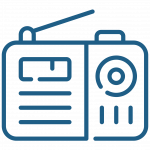With the political, social, and environmental pressures facing us in recent years, I am occasionally asked for my recommendation on personal communications technology. As such, I’ve put together this paper in the hopes that it will answer some of your questions. I must make an assumption about you, the reader, that you posess some average level of technological literacy. I am not writing this for communications experts and I offer this from the perspective of an American citizen.
Should I get a “shortwave” radio?
Short answer: Yes. I recommend a receiver like the C.Crane Skywave SSB. With it you can receive AM and FM broadcasts as well as international shortwave transmissions, amateur radio or “ham” communications, NOAA weather transmissions, and you can even monitor aircraft communications. These modern communication receivers pack a lot of high performance and features into a small, portable unit with very modest power requirements.
With that out of the way, let’s go a little deeper into the subject and try to set some expectations about the usefulness of such a radio in distressed times.
The AM and FM broadcast bands are not generally the reliable sources of information they once were. Many stations are staffed (or not) such that they are not really capable of providing emergency communications in the way they were in the past. And depending on the sort of emergency we are facing, the largely MSM controlled stations may not originate or carry the information that the preparedness and liberty minded individual seeks.
As far as shortwave goes, as I write this late in the year 2020, the vast majority of international broadcasters have ceased operations. There’s still a small handful of state owned broadcasters on the air and a few religious broadcasters of rather dubious theology. But overall, the news and information value of shortwave is diminished. This is to say nothing of the solar conditions that make long distance shortwave communication possible.
For a national emergency, I believe the NIST stations WWV and WWVH on 5, 10 and 15Mhz might be pressed into service if national broadcast infrastructure is incapable or unwilling to carry the information of national interest.
In summary, I recommend you have realistically low expectations of the reliability of broadcasters on AM, FM, and shortwave.
Can I get an easy-to-use shortwave radio that can talk to other people?
Short answer: Possibly.
Bringing the capability of transmitting really changes the discussion of communications preparedness. For regional and long distance two-way communications, amateur or “ham” radio is pretty much the only game in town.
Citizens Band or CB radios still exist and are easy-to-use but due to the position at the high end of the shortwave spectrum the reliable range is somewhat limited. But more important than the technical limitations of the equipment is the what I call the “social limitation” which I will talk about shortly. While I don’t recommend CB as the “go to” communication system, when things go sideways hard, then some radio is better than no radio.
Ham radio is great option, which I recommend. Ham radio is a licensed service which means that you are issued a set of call letters by the Federal Communication Commission. Obtaining a license is essentially free, but you have to pass a test indicating your knowledge of the rules and regulations of the service as well as some technical knowledge relating to radio and how to operate your station within the rules.
But can’t I just buy a ham radio without getting a license and only use it when the emergency hits? Well, yes you can purchase the equipment, but being able to use it effectively in an emergency requires practicing before the disaster strikes and that requires a license. Amateurs are patriotic and value law and order so I wouldn’t count on “bootlegging” your way into that group.
This brings me back to “social limitation” thing I mentioned before, and this applies to whatever technology you have. Just like the old saying “dig the well before you are thirsty”, your communication plan will be more effective when you build “your network” before you need to rely on it. But licensed or not, don’t expect a radio to magically connect you to the “outside” world if you’ve never taken the time make connections with other people. Strangers on the radio are still strangers and there is no guarantee or even likelihood that your interests are their priority.
From an equipment standpoint, modern commercially available amateur gear is high-tech, feature packed, and effective at getting on the air but using it requires more knowledge and skill than that of a consumer level radio listener. Gaining the knowledge and skill, and making the personal connections with other amateurs are the key ingredients to making ham radio a viable emergency communications option. Again, don’t show up on the day of the emergency with a ham radio still in the box and expect to be of any use.
